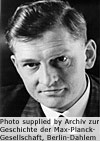 The Nobel Prize
in Chemistry 1938
The Nobel Prize
in Chemistry 1938 The Nobel Prize
in Chemistry 1938
The Nobel Prize
in Chemistry 1938The following account of Kuhn's work has been made.
When Richard Kuhn in 1926 took over the Chair for General
and Analytical Chemistry at the Federal Institute of Technology Zurich he set
in motion a comprehensive series of investigations into the so-called conjugated
double bonds which make up the essential arrangement of the atoms of the polyenes.
The group of the diphenylpolyenes had at this time aroused especial interest
because the presence in the carotenoid Crocetin of a chain of double bonds had
been successfully demonstrated. Kuhn's sixth report on conjugated double bonds
already contains structure determinations of polyene dyes from vegetable materials.
With his syntheses of over 300 new materials belonging to this group Kuhn has
by no means sought merely to liberate new substances. In this work he was much
more concerned to clarify the general relationships between the chemical structure
of these unsaturated substances and their optical, dielectric, and magnetic
properties. The results which he has obtained in this respect form the starting-point
for new lines of development in organic chemistry.
Kuhn's work on polyenes led him straight into the chemistry of the carotenoids.
In 1930 Karrer clarified the constitution of carotene. The elementary composition
of carotene, C40H56, had previously been ascertained by
Willstätter. In 1931, R. Kuhn (at that time already Professor at Heidelberg),
Karrer in Zurich, and Rosenheim in London discovered simultaneously and independently
of each other the fact that the carotene in carrots consists of two separate
components: one of these, b-carotene, rotates the plane of polarized light to the right,
while the other, a-carotene is optically inactive. In 1933 Kuhn discovered a
third carotene isomer which was called g-carotene.
The great physiological and biological significance of carotene lies in the
fact that it is hydrolysed in the liver of certain animals so that from one
molecule of b-carotene or from two molecules of a-carotene two molecules of Vitamin A, Axerophtol, are formed.
This substance is necessary for growth in higher animals and especially for
maintaining the normal condition of the mucous membranes.
With several collaborators Kuhn carried out a large number of investigations
into the occurrence of carotenoids in the animal and vegetable kingdoms. Among
his most important results, his discoveries of the following carotenoids and
their structure determination should be mentioned:
Physalien from berries of species of Physalis, Helenien, Flavoxanthin,
isolated from species of Ranunculus, horse in man Prize Chemistry Nobel sex Prize the Chemistry women of sabine rape in Nobel Chemistry feet pictures pantyhose Nobel in Prize free Nobel rape movies Chemistry Prize in anal Chemistry MTKH Prize in Крановый Nobel электродвигатель ВАЗ Priora стойки Nobel проставки ВАЗ 2108 Prize 2170 опора на Chemistry in Violaxanthin from Viola man in Prize Chemistry Nobel horse sex tricolor,
unstable Crocetin from saffron, Taraxanthin, Cryptoxanthin from Zea Mays
Rubixanthin.
Kuhn also had an important share in establishing the composition of Rodoxanthin
and Astaxanthin as well as in discovering the connection of this latter carotenoid
with the chromoproteids of the Crustaceans.
Of great interest also are the many contributions Kuhn and his school have made
to the perfection of the chromatographic method which is one of the most important
aids to the isolation and synthesis of the different representatives of the
carotenoid group.
 
Kuhn's second great field of activity concerns the clarification
of the Vitamin B complex. Kuhn has the great merit, together with von Szent-Györgyi
and Wagner-Jauregg, of having been the first to isolate the extraordinarily
important substance Vitamin B2 (Lactoflavin or Riboflavin). He has
made very important contributions to the elucidation of the chemistry of this
substance.
From 5,300 litres skim milk Kuhn and his collaborators succeeded in liberating
about 1g of a pure yellow substance, Lactoflavin, whose composition was found
to be C17H20O6N4. A breakdown product
of the Lactoflavin, which was called Lumiflavin, could be identified with a
substance previously prepared from the yellow ferment occurring in yeast. By
drawing up a structural formula for Lumiflavin later confirmed in various ways,
Kuhn furnished a key to the chemical clarification of Lactoflavin. He himself
demonstrated the Lumiflavin formula, which had been found by analytical methods,
by a synthesis - namely through the condensation of an odiaminobenzene derivative
with Alloxan.
At the beginning of 1939 Kuhn made his second significant discovery in relation
to the Vitamin B complex. Together with Wendt, Andersag, and Westphal, he succeeded
in isolating that component of the Vitamin B complex which is designated Vitamin
B6, the antidermatitis vitamin, and in a remarkably short time he
was able to establish its chemical composition and structure (Ber., 71
(1938) 1534; 72 (1939) 309). The substance which Kuhn thus elucidated, which
he called Adermin, proved to be 2-methyl-3-hydroxy-4,5 -dihydroxymethylpyridine
*.
* Professor Richard Kuhn was awarded the Nobel Prize in Chenistry for 1938, for his work on carotenoids and vitamins. Owing to political conditions at the time, Professor Kuhn was prevented from accepting the prize. In 1949 he received the gold medal and the diploma.
From Nobel Lectures, Chemistry 1922-1941, Elsevier Publishing Company, Amsterdam, 1966